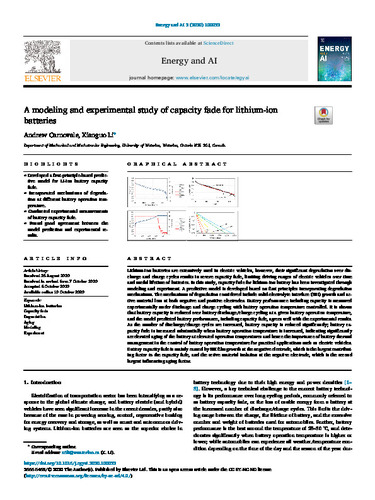| dc.contributor.author | Carnovale, Andrew | |
| dc.contributor.author | Li, Xianguo | |
| dc.date.accessioned | 2022-01-31 21:44:47 (GMT) | |
| dc.date.available | 2022-01-31 21:44:47 (GMT) | |
| dc.date.issued | 2020-11 | |
| dc.identifier.uri | https://doi.org/10.1016/j.egyai.2020.100032 | |
| dc.identifier.uri | http://hdl.handle.net/10012/18022 | |
| dc.description.abstract | Lithium-ion batteries are extensively used in electric vehicles, however, their significant degradation over discharge and charge cycles results in severe capacity fade, limiting driving ranges of electric vehicles over time and useful lifetime of batteries. In this study, capacity fade for lithium-ion battery has been investigated through modeling and experiment. A predictive model is developed based on first principles incorporating degradation mechanisms. The mechanisms of degradation considered include solid-electrolyte interface (SEI) growth and active material loss at both negative and positive electrodes. Battery performance including capacity is measured experimentally under discharge and charge cycling with battery operation temperature controlled. It is shown that battery capacity is reduced over battery discharge/charge cycling at a given battery operation temperature, and the model predicted battery performance, including capacity fade, agrees well with the experimental results. As the number of discharge/charge cycles are increased, battery capacity is reduced significantly; battery capacity fade is increased substantially when battery operation temperature is increased, indicating significantly accelerated aging of the battery at elevated operation temperatures and hence the importance of battery thermal management in the control of battery operation temperature for practical applications such as electric vehicles. Battery capacity fade is mainly caused by SEI film growth at the negative electrode, which is the largest contributing factor to the capacity fade, and the active material isolation at the negative electrode, which is the second largest influencing aging factor. | en |
| dc.description.sponsorship | Natural Sciences and Engineering Research Council of Canada || Dana Canada Corporation | en |
| dc.language.iso | en | en |
| dc.publisher | Elsevier | en |
| dc.relation.ispartofseries | Energy and AI; | |
| dc.rights | Attribution-NonCommercial-NoDerivatives 4.0 International | * |
| dc.rights.uri | http://creativecommons.org/licenses/by-nc-nd/4.0/ | * |
| dc.subject | lithium-ion batteries | en |
| dc.subject | capacity fade | en |
| dc.subject | degradation | en |
| dc.subject | aging | en |
| dc.subject | modeling | en |
| dc.subject | experiment | en |
| dc.title | A modeling and experimental study of capacity fade for lithium-ion batteries | en |
| dc.type | Article | en |
| dcterms.bibliographicCitation | Carnovale, A., & Li, X. (2020). A modeling and experimental study of capacity fade for lithium-ion batteries. Energy and AI, 2, 100032. https://doi.org/10.1016/j.egyai.2020.100032 | en |
| uws.contributor.affiliation1 | Faculty of Engineering | en |
| uws.contributor.affiliation2 | Mechanical and Mechatronics Engineering | en |
| uws.typeOfResource | Text | en |
| uws.peerReviewStatus | Reviewed | en |
| uws.scholarLevel | Faculty | en |


